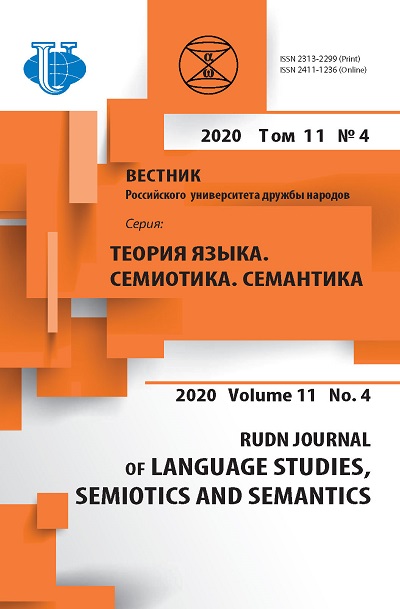Ta-Marbuta as Grammatical and Semantic Indicator: Harf or Affix?
- Authors: Zarytovskaya V.N.1
-
Affiliations:
- Peoples’ Friendship University of Russia (RUDN)
- Issue: Vol 11, No 4 (2020)
- Pages: 707-715
- Section: Functional grammar. Functional Semantics
- URL: https://journals.rudn.ru/semiotics-semantics/article/view/25046
- DOI: https://doi.org/10.22363/2313-2299-2020-11-4-707-715
Cite item
Full Text
Abstract
The article discusses the functional significance of such a graphic embodiment of the letter ta as ta-marbuta (ta-linked), which is not available in the Arabic alphabet. Traditionally included in Arabic studies in the phonetics-graphic section as a phenomenon specific to writing and reading rules, as well as a narrow grammar paragraph related to the female category indicator, ta-marbuta, as follows from the semantic comparison of the Arabic words selected by us, which in their own way morphological composition differ only in the presence of this affix, performs a more complex role in the language. The question is raised about the correctness of the name of ta-marbuta by letter (harf) or affix, the characteristics of which are inherent in it. The wide range of uses of ta-marbuta as a feminine affix, uniqueness affinity, substantiation, etc., as well as open and systematized semantic distinguishing shades of words with the same basis with ta-marbuta and without it, allow us to say that this affix has to be established as multifunctional and operates at various levels of the language - from morphology to semantics. Based on an analysis of the vast material, conclusions are drawn about the high productivity of ta-marbuta as an inflectional and word-formation formant, which allows transmitting a number of qualifying values, and not just a female affix. The lists of words that participate in word formation along with this affix are clarified - masdars of certain types of the verb, collective names, relative adjectives, less often high-quality adjectives, etc. All this ultimately speaks of the Arabic as a modern and developed language that can convey the most subtle semantic nuances, as well as having great potential for the formation of new lexical units.
Keywords
About the authors
Victoria N. Zarytovskaya
Peoples’ Friendship University of Russia (RUDN)
Author for correspondence.
Email: zarytovskaya-vn@rudn.ru
candidate of pedagogical sciences, associate professor of the Department of Foreign Languages, Faculty of Humanities and Social Sciences
6, Miklukho-Maklaya, Moscow, Russia, 117198References
- Vavichkina, T.A. (2003). Morphological structure of the verb in Arabic and Russian (typological analysis [dissertation]. Moscow. (In Russ.).
- Versteegh, K. (2001). The Arabic language. N.Y.: Columbia University Press.
- Sawaie, M. (2014). Fundamentals of Arabic grammar. London: Routledge.
- Yakovenko, E.V. (2000). Irregular verbs of the Arabic language. Moscow: Vostochnaya Literatura. (In Russ.).
- Dubinina, N.V. (2005). Verbs of the Arabic language. Right and wrong roots. Moscow: Vostok-Zapad. (In Russ.).
- Shelestova, O.V. (2008). Comparative analysis of word formation methods for affix verbs in English and Arabic. Vyatka State University Bulletin, 3, 122—126. (In Russ.)
- Al-Foadi, R.A. & Zarytovskaya, V.N. (2019). On the issue of internal root inflection in Arabic and Russian (inflective analysis of the root structure). Bulletin of the Saratov University. Series: Philology. Journalism, 19 (3), 268—275. (In Russ.).
- Al-Foadi, R.A. (2015). On the canonical phonogrammatic proximity of the dual in Russian and Arabic. Bulletin of the Nizhny Novgorod Lobachevsky University, 2, 157—161. (In Russ.).
- Dugalich N.M. (2020). Universal and Culturally Specific Features and Linguistic Peculiarities of The Political Cartoon in the Arabic and French Languages. RUDN Journal of Language Studies, Semiotics and Semantics, 11 (3), 479—495.
- Al Munjid (2000). Arabic-Arabic dictionary Beirut: Dar al-Mushriq. (In Arab.).
- Affix. Linguistic Encyclopedic Dictionary. URL: http://tapemark.narod.ru/les/index.html (accessed: 05/01/2020) (In Russ.).













